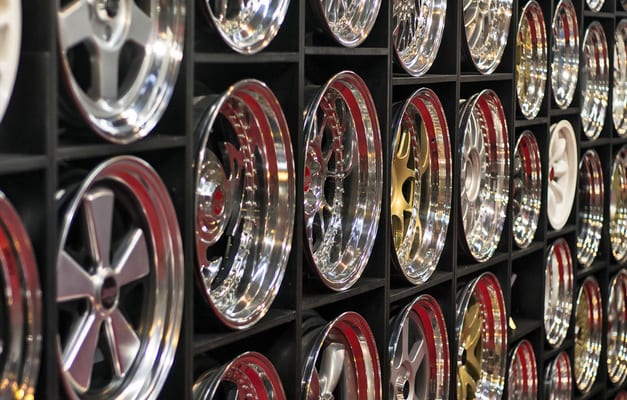
How to choose the right wheels for your car
Content
When car owners are faced with the replacement of one or all wheels, it turns out that choosing the right wheels is another task, because when choosing, you will have to take into account 9 parameters. Read on to learn how to make the right choice, focusing on the parameters of the wheel.
Disc types: stamped, cast, forged
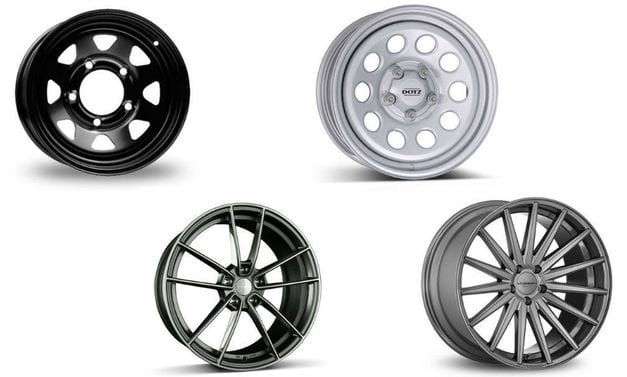
Today, there are three types of disks that are significantly different from each other:
- stamped. The simplest and cheapest type of disc that cars are equipped with to this day in the basic configuration. Made of steel and covered with enamel. Usually, the “stampings” are covered with plastic overlays to protect the disk and aesthetic appearance. The main advantage lies in the cost of the product and maintainability, since the iron disks after the impact are perfectly rolled, which makes it possible to further full-fledged operation. The main disadvantage is the large weight of the disk;
- cast. They are better known to us as alloy cars. The disk is made of aluminum, thanks to modern technologies it can have a different design, it weighs much lighter than “stampings”. Alloy wheels are more expensive, and their maintainability is zero (when the wheels hit, it cracks), although the technology of welding and rolling of such wheels has been mastered, but there will be no guarantee to preserve the factory properties;
- forged. The most high-quality and expensive wheels. Provide high strength with low weight hot stamping method. Due to this, “forging” is much more expensive than other wheels, but it holds the best blows and is less deformed during operation.
If you have to choose which of the three wheel options to put on your car, the first option will be more budgetary and practical, alloy wheels are more focused on aesthetics, and stamped, due to weight, allow you to save fuel and feel better on bad roads.
How to choose wheels for a car, selection parameters
For safe operation of the car, the correct wheels should be selected. On the body rack on the driver's side there is a table with valid wheel parameters, but there is information about the diameter of the wheel and tire sizes. In addition, there are a number of important parameters that you need to adhere to.
MOUNTING (LANDING) DIAMETER
The characteristic determines the diameter of the wheel circumference and is indicated by the letter R, for example: R13, R19, etc. The unit of measurement is an inch (1d = 2.54cm). It is important that the radius of the discs matches the recommendation of the car manufacturer. The rim and tire must also be the same radius! If the landing diameter of the wheel is smaller, this will reduce the maximum speed, pits and bumps will be felt more strongly. If, on the contrary, you install disks of a larger diameter, you will find:
- increased fuel consumption due to increased gear ratio and wheel weight;
- speedometer error
- reduction in the service life of wheel bearings.
NUMBER AND DIAMETER OF FASTENING HOUSES (PCD)
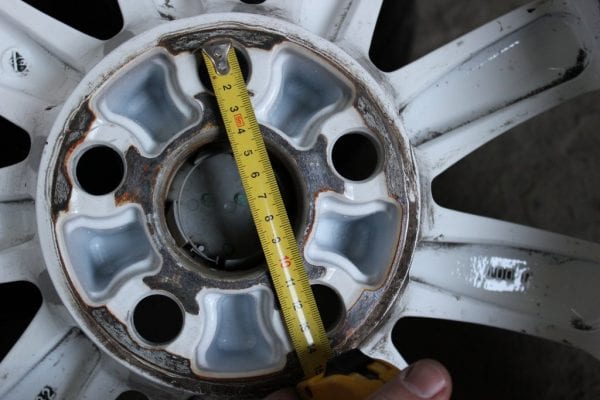
The people “bolt pattern” refers to the number of holes and the diameter of the circle where they are located. The number of wheel fasteners (usually from 4 to 6) is calculated based on the following factors:
- vehicle mass
- maximum speed.
For VAZ family cars, the PCD parameter is 4x98, and for the VAG auto concern 5 × 112.
It is important to observe the bolt pattern, because the difference between 5x100 and 5x112 is so significant that it leads to strong vibration when driving, as well as cutting off the wheel bolts. If there is an urgent need to install wheels with a difference between the bolts of a couple of mm, then for this there is a bolt with a floating cone to compensate for the difference.
Disk width
Wheel widths are also counted in inches, denoted as “J” (5,5J, etc.). The car manufacturer also indicates the nominal width of the wheels, usually allowing an increase of 0.5 inches. Wider wheels imply the installation of appropriate tires.
Departure of a wheel (ET)
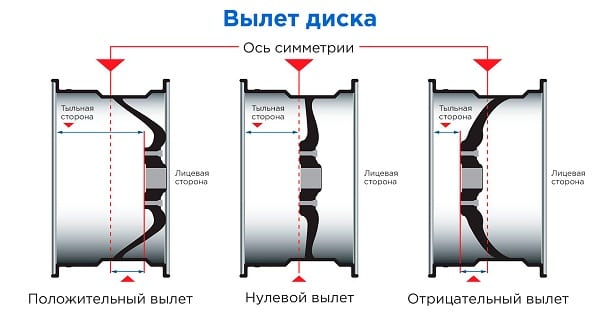
Departure means the distance from the central axis of the wheel to the plane of attachment to the hub, in simple words - how much the disk will protrude from the outside of the car. It is important to observe this parameter with an error of 5 mm, otherwise the disc may cling to the arch, suspension parts or brake caliper.
Departure is divided into three categories:
- positive - protrudes beyond the dimensions of the car;
- zero - the axial planes are the same;
- negative - the wheel “sits” more in the arch.
Departure also affects the life of the hubs, since deviation from the norms changes the angle of distribution of the load on the bearing. If you need a larger overhang, this can be achieved from a standard drive by using hub spacers to increase the track.
CENTRAL (HUB) HOLE DIAMETER
In the list of characteristics, the diameter of the center is designated as “DIA”. This indicator is important in that when installing wheels with a lower DH will be impossible, and to install a disk with a hole diameter larger than necessary, the issue is solved by installing centering rings.
It is strictly forbidden to install disks with a large color center without rings, thinking that they themselves are centered due to the mounting bolts. In fact, this will be accompanied by a strong beating, vibration and imbalance. In the worst case, this will lead to the cutting of the hub studs or bolts.
Mounting Hole Shape
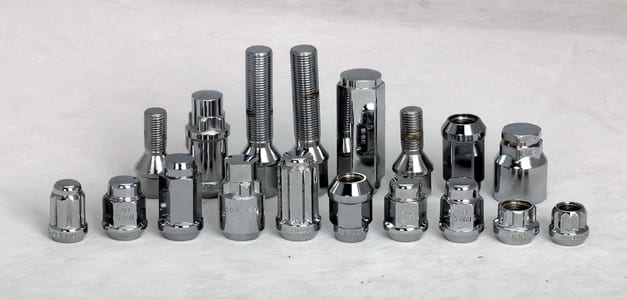
It is extremely important to choose the right bolts or nuts if your car, for example, went on iron rims, and now cast or forged ones are installed. The difference between the bolts lies in their shape: for “stamping” the bolts have a slightly conical shape, for light alloys - pronounced conical and hemispherical bolts.
The fastening nut can be open or closed, the fundamental difference is only in aesthetics.
Floating-cone bolts (eccentrics), as mentioned above, compensate for the difference between the PCD disc and the hub. However, such bolts only partially save the situation, and you should not count on long-term operation with eccentrics.
The presence of humps
Humps are protrusions that hold the tubeless tire on the disk. By the way, those same pops when inflating a tire at a tire fitting indicate the installation of a side ring of the tire between the hop and the rim of the wheel. In the characteristics of modern wheels you will not find this parameter, since it is the same for everyone (chamber wheels have not been produced for a long time). Checking the wheels for the presence of humps is recommended for Soviet-made cars where cameras were used in the tires.
Questions and answers:
How do I know what drives I have on my machine? Most discs are marked on the inside of the sidewall, some on the hub section between the mounting bolts or outside on the rim.
How to choose the right alloy wheels? The landing width (rims), the size of the landing diameter, the number and distance between the fastening bolts, the hub seat, the disc overhang are the main factors that need to be paid attention to.
How to find out what is the offset of the disk? To do this, the ET parameter is indicated in the disc marking. It is calculated by the formula ab / 2 (a is the distance between the inner edge of the disc and the hub plane, b is the total width of the disc).
